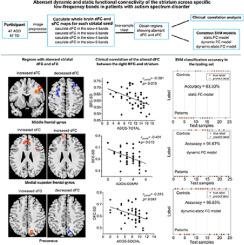Psychiatry Research: Neuroimaging ( IF 2.3 ) Pub Date : 2023-11-10 , DOI: 10.1016/j.pscychresns.2023.111749 Junsa Zhu 1 , Yun Jiao 2 , Ran Chen 1 , Xun-Heng Wang 3 , Yunyan Han 4

|
Background
Dysfunctions of the striatum have been repeatedly observed in autism spectrum disorder (ASD). However, previous studies have explored the static functional connectivity (sFC) of the striatum in a single frequency band, ignoring the dynamics and frequency specificity of brain FC. Therefore, we investigated the dynamic FC (dFC) and sFC of the striatum in the slow-4 (0.027-0.073 Hz) and slow-5 (0.01-0.027 Hz) frequency bands.
Methods
Data of 47 ASD patients and 47 typically developing (TD) controls were obtained from the Autism Brain Imaging Data Exchange (ABIDE) database. A seed-based approach was used to compute the dFC and sFC. Then, a two-sample t-test was performed. For regions showing abnormal sFC and dFC, we performed clinical correlation analysis and constructed support vector machine (SVM) models.
Results
The middle frontal gyrus (MFG), precuneus, and medial superior frontal gyrus (mPFC) showed both dynamic and static alterations. The reduced striatal dFC in the right MFG was associated with autism symptoms. The dynamic‒static FC model had a great performance in ASD classification, with 95.83 % accuracy.
Conclusions
The striatal dFC and sFC were altered in ASD, which were frequency specific. Examining brain activity using dynamic and static FC provides a comprehensive view of brain activity.
中文翻译:

自闭症谱系障碍患者特定低频段纹状体动态和静态功能连接异常
背景
在自闭症谱系障碍(ASD)中反复观察到纹状体功能障碍。然而,之前的研究探索了纹状体在单一频段的静态功能连接(sFC),忽略了大脑FC的动态和频率特异性。因此,我们研究了慢4(0.027-0.073 Hz)和慢5(0.01-0.027 Hz)频段纹状体的动态FC(dFC)和sFC。
方法
47 名 ASD 患者和 47 名典型发育 (TD) 对照的数据来自自闭症脑成像数据交换 (ABIDE) 数据库。基于种子的方法用于计算 dFC 和 sFC。然后,进行双样本t检验。对于sFC和dFC异常的区域,我们进行临床相关性分析并构建支持向量机(SVM)模型。
结果
额中回(MFG)、楔前叶和内侧额上回(mPFC)显示出动态和静态改变。右侧 MFG 纹状体 dFC 的减少与自闭症症状相关。动静态FC模型在ASD分类方面表现出色,准确率达到95.83%。
结论
纹状体 dFC 和 sFC 在 ASD 中发生改变,具有频率特异性。使用动态和静态 FC 检查大脑活动可以提供大脑活动的全面视图。



























 京公网安备 11010802027423号
京公网安备 11010802027423号